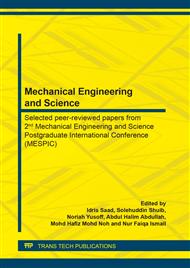[1]
A.R.M. Sahab, N.H. Saad, A. Hamidi, and D. Said, Integrated Process of Ceramic Slip Using Rotating Technique,, 2nd Adv. Mater. Confererence 2014, vol. 1133, no. 1, pp.161-165, (2016).
DOI: 10.4028/www.scientific.net/amr.1133.161
Google Scholar
[2]
N.H. Saad, A.R.M. Sahab, M.M.M. Mohtar, F.M. Salleh, I. Tharazi, and J. Saedon, Formation of Hollow Shape Porcelain By Using a New Integrated Slip Rotary Moulding Technique,, J. Teknol., vol. 76, no. 6, (2015).
DOI: 10.11113/jt.v76.5673
Google Scholar
[3]
Serope Kalpakjian and Steven R. Schmid, Manufacturing, Engineering & Technology, Vol. 5, 8t. Pearson Education, (2006).
Google Scholar
[4]
Mikell P.Groover, Principles OF Modern Manufacturing, 4th ed. John Wiley & Sons, (2013).
Google Scholar
[5]
N.H. Ab. Wahab, N.H. Saad, A.R.M. Sahab, A. Abd, and N. Nasir, The Effect of Water/Plaster Ratio Variation On Absorption Properties and Flexural Strength of Gypsum Plaster,, vol. 28, no. 5, p.4501–4504, (2016).
Google Scholar
[6]
M. S. Attar, H. R. Nemati, R. Sarjahani, and G. Fars, Analysis and Optimization of Using Hemihydrates Plaster ( β ) for Casting Mould in Sanitary ware Industry,, Ceram. Mater., vol. 1, no. 63, p.143–146, (2011).
Google Scholar
[7]
I. a H. Al-Dawery, J.G.P. Binner, G. Tari, P.R. Jackson, W.R. Murphy, and M. Kearns, Rotary moulding of ceramic hollow wares,, J. Eur. Ceram. Soc., vol. 29, no. 5, pp.887-891, (2009).
DOI: 10.1016/j.jeurceramsoc.2008.07.021
Google Scholar
[8]
R. Mehta, Hollow ceramics component produced by rotary moulding cuts cost,, M.PROFESSIONAL, p.2–3, (2014).
Google Scholar
[9]
Y. Zhang and J. Binner, Enhanced casting rate by dynamic heating during slip casting,, J. Eur. Ceram. Soc., vol. 22, no. 1, p.135–142, (2002).
DOI: 10.1016/s0955-2219(01)00243-6
Google Scholar
[10]
A. Matsumoto, Advanced Processing and Manufacturing Technologies for Nanostructured and Multifunctional Materials II: A Collection of Papers Presented at the 39th International Conference on Advanced Ceramics and Composites (eds T. Ohji, M. Singh and M. Halbig), Vol. 36,no. John Wiley & Sons, (2015).
DOI: 10.1002/9781119211662
Google Scholar
[11]
J. Bruno, Process for producing casting molds suitable for use in the ceramic industry,, US3929685 A, (1975).
Google Scholar
[12]
Ceramic Industry Magazine, How Low Can You Go?,, ceramicindustry.com, 2002. [Online]. Available: https://www.ceramicindustry.com/articles/85078-how-low-can-you-go.
DOI: 10.14325/mississippi/9781496828118.003.0029
Google Scholar
[13]
D570, Water Absorption of Plastics 1,, ASTM Stand., vol. 98, no. Reapproved 2010, p.25–28, (2014).
Google Scholar
[14]
ASTM International, ASTM D 790 - 02 - Flexural Properties of Unreinforced and Reinforced Plastics and Electrical Insulating Materials,, vol. 14, p.146–154, (2002).
Google Scholar
[15]
H. Giesche, Mercury Porosimetry: A General (Practical) Overview,, Part. Part. Syst. Charact., vol. 23, no. 1, p.9–19, Jun. (2006).
DOI: 10.1002/ppsc.200601009
Google Scholar
[16]
N.H. Wahab, N. H. Saad, and N. Nasir, Plaster Mould Selection for Ceramic Slip Rotary Moulding System ( CSRM ),, vol. 13, no. 2, p.10–20, (2017).
DOI: 10.4028/www.scientific.net/amm.899.187
Google Scholar
[17]
SACMI Group, Resin moulds: the result of technical and technological product innovation., (2013).
Google Scholar
[18]
H. Ito and A. Matsumoto, Porous mold for pressure slip casting,, US4874304 A, (1989).
Google Scholar


